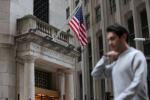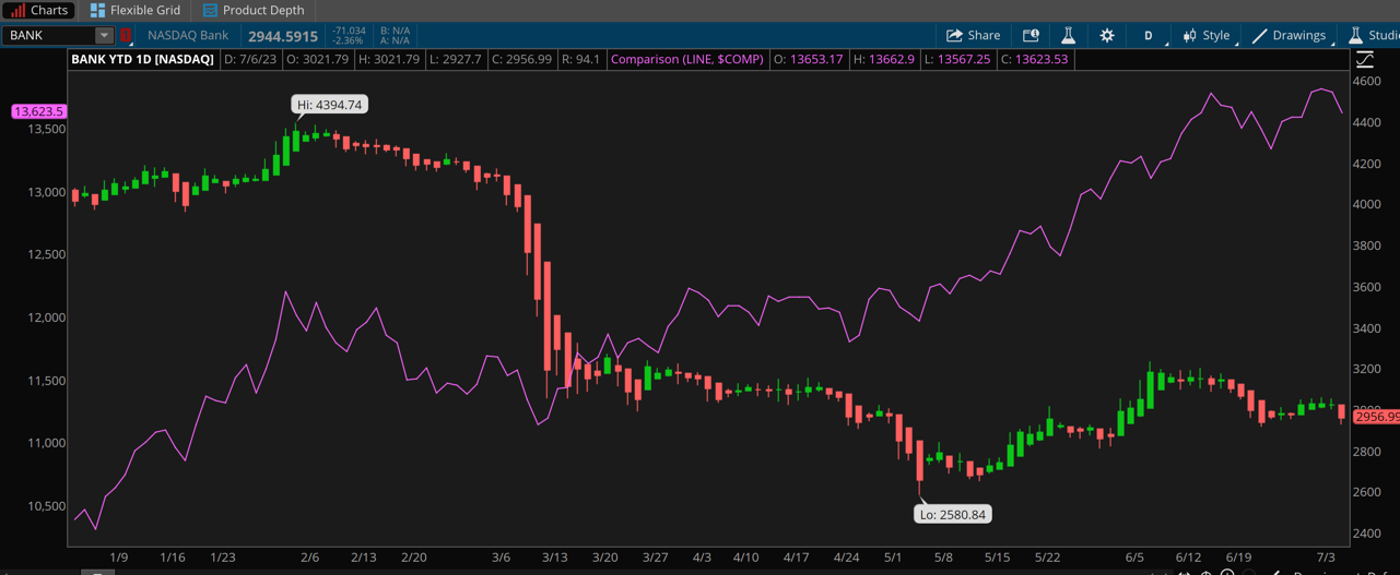
- All Instrument Types
- Indices
- Equities
- ETFs
- Funds
- Commodities
- Currencies
- Crypto
- Bonds
- Certificates
Please try another search

Q2 Financials Sector Earnings Outlook: Big Banks Kick off Season

The nation’s largest banks delivered resilient Q1 earnings driven by solid net interest income despite industry turmoil. However, because that unease surfaced midway through March, it’s arguable the last set of earnings results didn’t reflect the full extent of the troubles.
Now Q2 earnings season approaches, putting pressure on big banks to prove they stayed resilient through an entire quarter even as credit conditions tightened. They might get a continued boost from net interest income, the money they make lending minus what they pay to customers.
Bank earnings often set the tone for the entire reporting season. Banks are closer to the heartbeat of most industries, so their results and observations merit a close look. The parade of banks starts Friday, July 14, before the open with expected results from JPMorgan Chase (NYSE:JPM), Citigroup (NYSE:C), and Wells Fargo (NYSE:WFC). That’s followed on Tuesday, July 18, by Bank of America (NYSE:BAC) and Morgan Stanley (NYSE:MS). Then Goldman Sachs (NYSE:GS) wraps things up next Wednesday.
Smaller banks remain under the microscope too, because that segment suffered most from the spring turmoil that included several U.S. bank failures. Regional bank earnings to watch include PNC Financial Services (NYSE:PNC), expected to report next Tuesday, M&T Bank Corp (NYSE:MTB) and U.S. Bancorp (NYSE:USB) next Wednesday, and Regions Financial (NYSE:RF) on Friday, July 21. Worries about smaller banks might be a boost for larger financial institutions in terms of deposits in Q2, assuming clients pulled money out of the smaller banks and sought “safety” at larger ones.
Deposit levels remain a concern. Though Treasury yields are down from their peaks last fall, they remain at levels high enough to provide competition for banks trying to attract deposits, and banks continue to raise the interest they pay out on short-term investments to try and keep cash in the system.
Another headwind that didn’t go away is the inverted yield curve, in which long-term U.S. rates remain well below short-term ones. The curve between the 2-year and 10-year Treasury note yields expanded sharply in Q2 to above 100 basis points again. This can hurt bank earnings because banks tend to borrow in the short term and lend for the long term.
On a more positive note, all major U.S. banks passed the Federal Reserve’s annual “stress test” that determines if they have enough capital to continue functioning through a major financial shock. BAC celebrated by raising its dividend last week. Earnings season might see more of its counterparts do so as well.
Credit check
Depending on future rate moves from the Fed and other operating and economic factors ahead, lending could still tighten for consumers and businesses. In fact, there’s already been some tightening since spring, though corporate credit appears to remain in relatively solid shape, judging from yields for both investment grade and high-yield debt offerings.
If banks and their balance sheets come under more scrutiny, institutions may become more reluctant to lend to certain businesses and that could dry up venture capital, commercial real estate, and other businesses dependent on a relatively free flow of funds. One potential soft spot appears to be the automobile market, where credit availability could be a second-half challenge, according to Cox Automotive, an automotive services and technology provider.
Ask your banker
To get a better sense of things are going beyond simple top- and bottom-line numbers, here are some questions big bank CEOs might be asked on their earnings calls:
- How was loan volume in Q2, and what are banks’ forecasts for loan volume in Q3 and beyond?
- Are defaults likely to rise, and if so, in which industries?
- How are banks doing in regard to unrealized losses in the bond market?
- How are deposit trends, and are banks paying more interest to keep depositors? If so, what would be the impact on margins?
- How did the expanding inversion between short-term and long-term yields in Q2 affect profitability for the big banks, and is that spread near a peak?
- Could the mergers and acquisitions (M&A) market pick up in the second half as interest rates appear to be nearing a top?
- Do banks think recession is likely, and, if so, how deep will it be?
- Did banks continue to put aside loan loss reserves in Q2 to protect from possible loan defaults?
Whatever the answers to these questions, the financials sector remains relatively stuck in terms of stock market performance. Although things improved a bit in June, the Nasdaq Bank Index (BANK)—which includes all bank stocks, not just the biggest ones—lost additional ground in Q2 after a very tough Q1. It’s down 25% from a year ago.
Will banks still beat analysts’ estimates?
Big banks have a long history of exceeding Wall Street’s expectations. It happened again last quarter and injected vigor into the early days of Q1 earnings season.
Still, there are reasons to wonder if that’s necessarily the case going into Q2, especially considering that analysts pared their earnings per share (EPS) expectations for the financials sector over the last three months, according to FactSet. The sector’s EPS grew 5% year over year in Q1 despite a slight fall in profit margins and is seen growing 5.3% in Q2. However, that estimate is down from the March 31 average analyst EPS growth forecast of 8.4%. All five financials subindustries are seen reporting EPS growth, led by consumer finance (15%) and banks (14%), FactSet said.
Parsing portfolios
When the big banks report, keep an eye on the general level of loan activity and the quality of their existing loans. The main thing to watch here is how much, if anything, they added to provisions for credit losses. More capital set aside for that indicates increased fears of default and also would weigh on earnings.
Here’s a quick look at what to watch for as major banks report.
JPMorgan Chase
Scheduled Report Date: Friday, July 14, before opening bell
- Expected Q2 EPS (analysts’ consensus): $3.97
- Year-ago EPS: $2.76
- Expected Q2 revenue (analysts’ consensus): $38.96 billion
- Year-ago revenue: $35.37 billion
JPM kicked off the last two earnings season with positive outcomes, beating analysts’ Q4 and Q1 EPS and revenue estimates. The biggest U.S. bank enjoyed a positive tailwind the last two quarters from net interest income. Last time out, JPM raised its guidance for net interest income to $81 billion for the year, up $7 billion from its previous forecast.
Net interest generated profits for JPM in Q1, but that could level off for JPM and other banks as comparisons get tougher through 2023. Banks could also feel pressure to raise deposit rates to keep customers from chasing higher yields elsewhere, a move that would possibly narrow profit margins.
Another potential profit eater is setting aside additional loan loss reserves, something all big banks have been doing almost constantly since the pandemic started three years ago. Last quarter, JPM set aside loan loss provisions of $2.3 billion, up more than 50% from a year earlier, citing economic and geopolitical worries. CEO Dimon said then that “storm clouds remain on the horizon” and that the then-recent banking turmoil added to the risk.
While Dimon kept a cautious view, JPM’s banking business looked strong in Q1 in terms of deposits and new accounts. Both metrics remain worth watching in Q2.
Citigroup
Scheduled Report Date: Friday, July 14, before opening bell
- Expected Q2 EPS (analysts’ consensus): $1.43
- Year-ago EPS: $2.19
- Expected Q2 revenue (analyst’ consensus): $19.67 billion
- Year-ago revenue: $19.64 billion
C posted stronger year-over-year earnings and revenue in Q1, but analysts expect a softer Q2 with EPS down 35% year over year and just a sliver of revenue growth. A 4% rise in fixed income market revenue in Q1 might be tough to beat sequentially considering the markets had less volatility later in Q2.
Another thing to remember is that the company’s strong Q1 earnings benefited from a one-time event, the sale of its India-based consumer business. At the same time, C is expanding its Chinese business, CEO Jane Fraser said in June when she visited the Asian country.
Last quarter, executives at C noted slower consumer spending and predicted a “shallow recession” later this year, keeping guidance unchanged. Investment banking is a big business for Citigroup, but this year’s weak initial public offerings (IPO) and M&A environment continue to test C and other major investment banks.
Investors will likely receive an update on C’s regulatory issues. The company got hit in 2020 with a government consent order to improve its risk management and internal controls. Then last November, the Federal Reserve cited a “shortcoming” pertaining to “data quality and data management” in part of the bank’s business. There hasn’t been much news on this front lately, so we’ll see if the company provides any word.
Wells Fargo
Expected Report Date: Friday, July 14, before opening bell
- Expected Q2 EPS (analysts’ consensus): $1.19
- Year-ago EPS: $0.74
- Expected Q2 revenue (analysts’ consensus): $20.07 billion
- Year-ago revenue: $17.03 billion
Like C, WFC has been beset by regulatory issues in the last few years. However, analysts expect a blowout quarter in Q2. Shares climbed from the March lows but remain below their 2023 highs. Soaring net-interest income led to an earnings beat in Q1, and continued interest rate strength in Q2 could remain a tailwind.
One worry for WFC is the tightening of credit conditions, according to an analysis in May by JPM. The bank has heavy exposure to loans for autos and commercial real estate. This could put more pressure on WFC to set funds aside for possible loan defaults, a move that would hurt profitability. The bank set aside $1.2 billion for credit losses in Q1, including $643 million for potential losses related to commercial real estate, credit cards, and auto loans.
WFC announced earlier this year it plans to downsize the home mortgage business it once dominated in light of rising rates and continued regulatory scrutiny. The nation’s No. 1 mortgage lender as late as 2019 will continue to offer home loans only to existing bank and wealth management customers and borrowers in minority communities.
One thing to watch is what WFC might say about credit quality and consumer spending, as well as deposit balances and credit quality. It sounded upbeat on those metrics late last year.
Bank of America
Expected Report Date: Tuesday, July 18, before opening bell
- Expected Q2 EPS (analysts’ average estimate): $0.85
- Year-ago EPS: $0.73
- Expected Q2 revenue (analysts’ average estimate): $25.16 billion
- Year-ago revenue: $22.79 billion
Like other banks, BAC got a nice tailwind from net interest income in Q1, and it wouldn’t be shocking to see that continue in Q2 based on the path of rates. Deposits fell sequentially in Q1, but conceivably might see an upswing in Q2 as big banks potentially benefited from turmoil at smaller institutions.
Also like other major banks, BAC is exposed to unrealized losses in its bond portfolio. Sometimes the banks report these “losses” in earnings, but other times investors need to wait until their 10-Q filings with the Securities and Exchange Commission (SEC). BAC had the largest mark-to-market loss on its bond security portfolio among banks at the end of 2022, at about $109 billion, Barron’s reported.
BAC added more reserves for possible credit losses in Q1 but at a lower level than some other banks. BAC has a massive consumer banking franchise, and it’ll be interesting to hear its views on consumer confidence and whether it foresees an economic downturn.
Morgan Stanley and Goldman Sachs: Both are expected to report slightly better year-over-year earnings, with revenue rising slightly for MS and falling for GS.
***
Disclosure: TD Ameritrade® commentary for educational purposes only. Member SIPC. Options involve risks and are not suitable for all investors. Please read Characteristics and Risks of Standardized Options.
Related Articles

The last 18 months have been like an ice age for investment bankers brokering deals and young business owners looking to tap extra capital Several successful recent IPOs may...

Q2 earnings season kicks off with the banking sector entering the limelight Banking crisis concerns have abated following stress tests by the Fed Big players Citigroup, JPMorgan,...

Stocks have rallied since June, aided by significant capital inflows But some stocks have lagged behind Let's take a look at three such stocks trading below their target prices...
Are you sure you want to block %USER_NAME%?
By doing so, you and %USER_NAME% will not be able to see any of each other's Investing.com's posts.
%USER_NAME% was successfully added to your Block List
Since you’ve just unblocked this person, you must wait 48 hours before renewing the block.
I feel that this comment is:
Thank You!
Your report has been sent to our moderators for review





Add a Comment
We encourage you to use comments to engage with other users, share your perspective and ask questions of authors and each other. However, in order to maintain the high level of discourse we’ve all come to value and expect, please keep the following criteria in mind:
Enrich the conversation, don’t trash it.
Stay focused and on track. Only post material that’s relevant to the topic being discussed.
Be respectful. Even negative opinions can be framed positively and diplomatically. Avoid profanity, slander or personal attacks directed at an author or another user. Racism, sexism and other forms of discrimination will not be tolerated.
Perpetrators of spam or abuse will be deleted from the site and prohibited from future registration at Investing.com’s discretion.